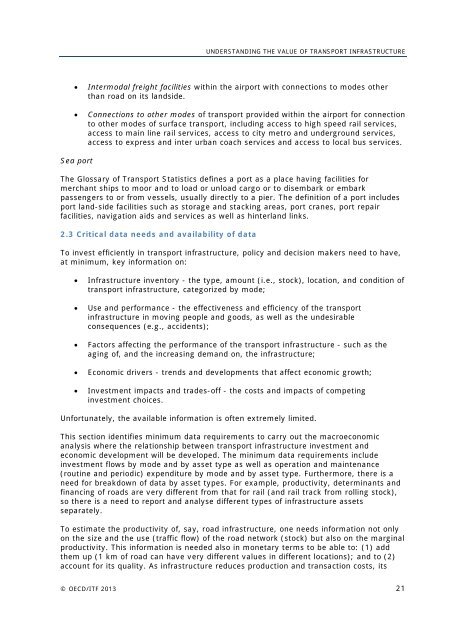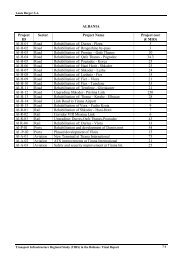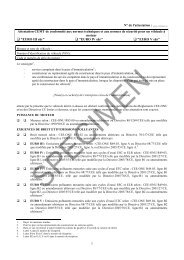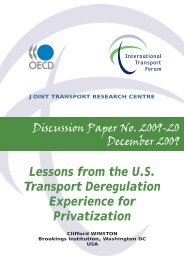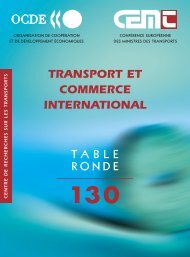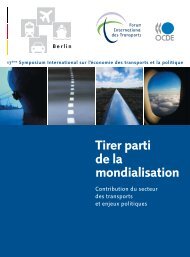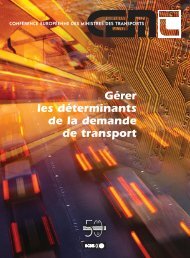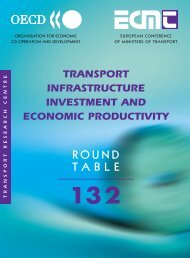Understanding the Value of Transport Infrastructure ...
Understanding the Value of Transport Infrastructure ...
Understanding the Value of Transport Infrastructure ...
You also want an ePaper? Increase the reach of your titles
YUMPU automatically turns print PDFs into web optimized ePapers that Google loves.
UNDERSTANDING THE VALUE OF TRANSPORT INFRASTRUCTURE<br />
• Intermodal freight facilities within <strong>the</strong> airport with connections to modes o<strong>the</strong>r<br />
than road on its landside.<br />
• Connections to o<strong>the</strong>r modes <strong>of</strong> transport provided within <strong>the</strong> airport for connection<br />
to o<strong>the</strong>r modes <strong>of</strong> surface transport, including access to high speed rail services,<br />
access to main line rail services, access to city metro and underground services,<br />
access to express and inter urban coach services and access to local bus services.<br />
Sea port<br />
The Glossary <strong>of</strong> <strong>Transport</strong> Statistics defines a port as a place having facilities for<br />
merchant ships to moor and to load or unload cargo or to disembark or embark<br />
passengers to or from vessels, usually directly to a pier. The definition <strong>of</strong> a port includes<br />
port land-side facilities such as storage and stacking areas, port cranes, port repair<br />
facilities, navigation aids and services as well as hinterland links.<br />
2.3 Critical data needs and availability <strong>of</strong> data<br />
To invest efficiently in transport infrastructure, policy and decision makers need to have,<br />
at minimum, key information on:<br />
• <strong>Infrastructure</strong> inventory - <strong>the</strong> type, amount (i.e., stock), location, and condition <strong>of</strong><br />
transport infrastructure, categorized by mode;<br />
• Use and performance - <strong>the</strong> effectiveness and efficiency <strong>of</strong> <strong>the</strong> transport<br />
infrastructure in moving people and goods, as well as <strong>the</strong> undesirable<br />
consequences (e.g., accidents);<br />
• Factors affecting <strong>the</strong> performance <strong>of</strong> <strong>the</strong> transport infrastructure - such as <strong>the</strong><br />
aging <strong>of</strong>, and <strong>the</strong> increasing demand on, <strong>the</strong> infrastructure;<br />
• Economic drivers - trends and developments that affect economic growth;<br />
• Investment impacts and trades-<strong>of</strong>f - <strong>the</strong> costs and impacts <strong>of</strong> competing<br />
investment choices.<br />
Unfortunately, <strong>the</strong> available information is <strong>of</strong>ten extremely limited.<br />
This section identifies minimum data requirements to carry out <strong>the</strong> macroeconomic<br />
analysis where <strong>the</strong> relationship between transport infrastructure investment and<br />
economic development will be developed. The minimum data requirements include<br />
investment flows by mode and by asset type as well as operation and maintenance<br />
(routine and periodic) expenditure by mode and by asset type. Fur<strong>the</strong>rmore, <strong>the</strong>re is a<br />
need for breakdown <strong>of</strong> data by asset types. For example, productivity, determinants and<br />
financing <strong>of</strong> roads are very different from that for rail (and rail track from rolling stock),<br />
so <strong>the</strong>re is a need to report and analyse different types <strong>of</strong> infrastructure assets<br />
separately.<br />
To estimate <strong>the</strong> productivity <strong>of</strong>, say, road infrastructure, one needs information not only<br />
on <strong>the</strong> size and <strong>the</strong> use (traffic flow) <strong>of</strong> <strong>the</strong> road network (stock) but also on <strong>the</strong> marginal<br />
productivity. This information is needed also in monetary terms to be able to: (1) add<br />
<strong>the</strong>m up (1 km <strong>of</strong> road can have very different values in different locations); and to (2)<br />
account for its quality. As infrastructure reduces production and transaction costs, its<br />
© OECD/ITF 2013 21


